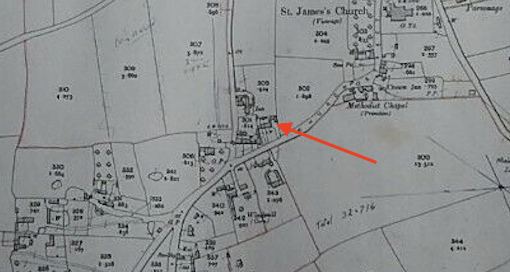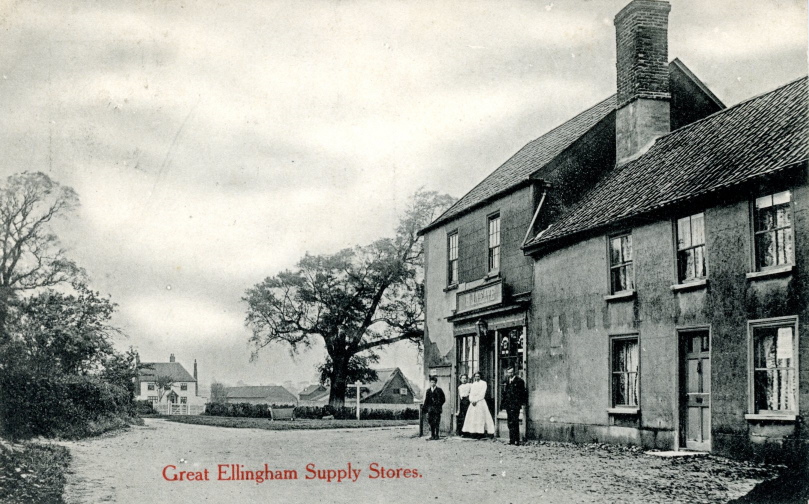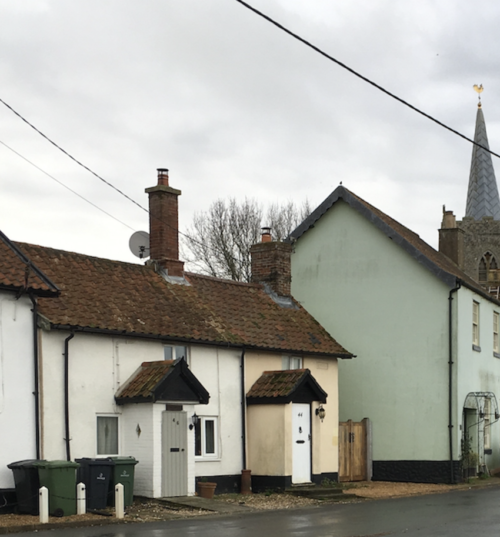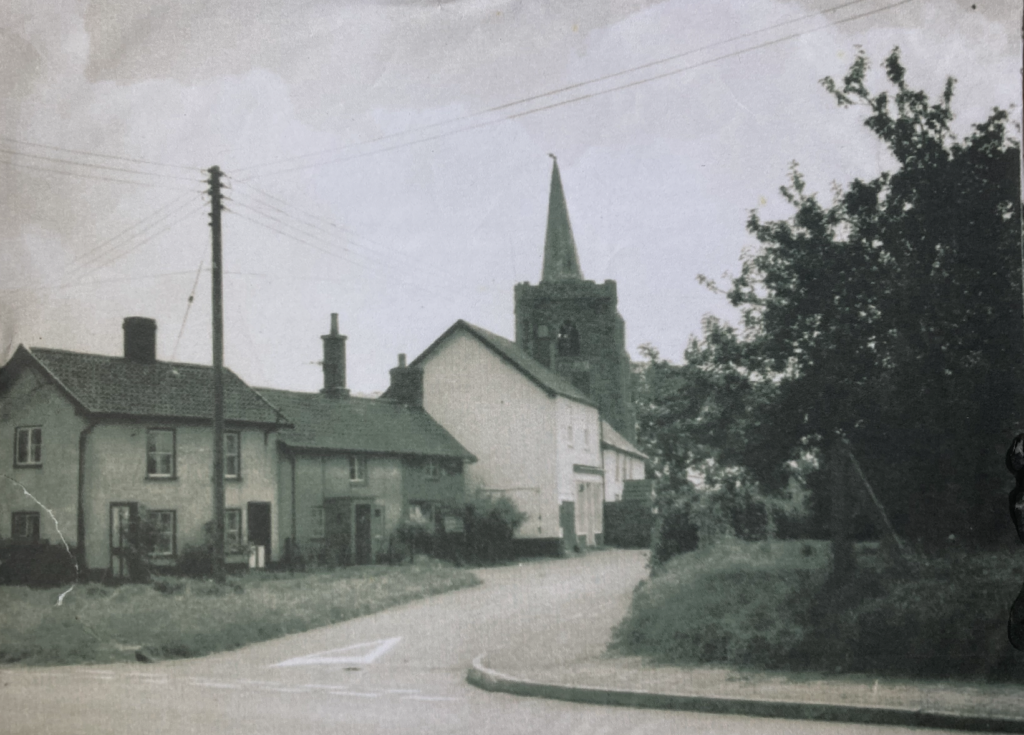It was not until relatively recent times that property ownership in Britain became accessible and achievable. In the past, many houses were rented from private landlords.
Many of these private landlords also owned other properties in different towns or villages – some of which were a distance from where they lived.
Great Ellingham once comprised several tenanted properties owned by landlords living elsewhere.
Thomas Leeder was one such landlord. I also believe Thomas Leeder owned more than one property in the village.
Thomas Leeder, owner of Cottage in Church Street

Extract from 1906 Ordnance Survey Map. Second Edition. Surveyed in 1881. Revised 1904.
Whilst looking at the history of a semi-detached cottage in Church Street, I discovered that Thomas Leeder of 7 Mincing Lane, London owned the cottage in the 1870s. The red arrow on the above map shows location of this cottage in Church Street.
Although he lived in London, Thomas Leeder was a ‘Great Ellingham man’. He was born in the village around 1827.
The provisions of Thomas Leeder’s last will and testament together with the historical deeds to the semi-detached cottage, tell us that Thomas’s son, Walter inherited the semi-detached cottage from his father. However, this was subject to the life tenancy of his mother, Louisa.
Following Louisa Leeder’s death in 1893, the legal title to the semi-detached cottage was conveyed to Walter Leeder on the 23rd May, 1894.
However, the day after the conveyance of the property to Walter, on the 24th May, 1894 he sold the property to George Henry de la Cour of Chatham, Kent. De la Cour happens to be one of the executors of Walter’s late father’s will.
We can but wonder why Walter immediately sold the property? Perhaps he had no interest in an investment many miles from where he lived – or, maybe, he needed the money!
De la Cour owned the semi-detached cottage until his death in 1914. His executor, Henry George Allen (also of Chatham, Kent), sold the property to Henry Newby on the 19th July, 1920.
Shop and House
Since investigating the history of the semi-detached cottage, I have looked at the history of other properties in Church Street.

Extract from 1906 Ordnance Survey Map. Second Edition. Surveyed in 1881. Revised 1904.
In particular, two properties which formerly comprised a shop with a dwelling house. For many, many years, these properties were owned together with one legal title.
The blue arrow on the above map from 1906 shows the position of the house and shop in Church Street.
Ownership Link
What is remarkable (but, I guess, not surprising) is that the historical deeds to this property (i.e. the shop and house) refer to the very same Conveyance deed dated 24th May, 1894, between Walter Leeder and George Henry de la Cour, which is also referred to in the title deeds to the semi-detached cottage referred to above.
Given that Walter Leeder disposed of both the semi-detached cottage and the shop with house the day after the legal title to the properties were conveyed to him, I think it unlikely that Walter Leeder previously purchased the shop and house.
Accordingly it is more than likely that Walter Leeder also inherited the shop and house from his father, Thomas Leeder.
Earlier History of the House & Shop

Neave’s Supply Stores. Possibly dating from early 20th century.
Shop and House owned by William Rose at the end of the 18th century.
Author’s collection
Towards the end of the 18th century, the house and shop were owned and occupied by William Rose. Rose also owned other neighbouring properties. At that time, the semi-detached cottage (towards the other end of Church Street) was owned by Mary Warren, who also owned the Chequers Public House.
As far as I know, the Rose family owned (and likely occupied) the shop and house until at least the 1840s.
However, I do not know when Thomas Leeder purchased the shop and house – assuming that he did.
1875 Tender for Works
I believe Thomas Leeder was a speculator.
On the 3rd July, 1875, the Norfolk News published the following notice:
Tenders required for the erection of two cottages, shop and premises &c at Great Ellingham, Norfolk. Plans and specifications may be seen at Mr Lebbell’s, Crown Inn, Great Ellingham. Tenders to be sent to Mr T Leeder, 7 Mincing Lane, London before the 16th July next
The following year, the Norfolk Chronicle of 4th March, 1876, published the following notice of auction:
GREAT ELLINGHAM
TO GROCERS, DRAPERS, FLOUR SELLERS, AND GENERAL SHOPKEEPERS
TO BE SOLD BY AUCTION, BY MESSRS STANDLEY AND SONS, at the
Crown Inn, Great Ellingham on Monday , March 6th, 1876, at Four for Five o’clock in the Afternoon,
all that MESSUAGE, with large Shop extensive Warehouses, Cellar, Stable, Gig-house, and other Outbuildings, Yard and Garden situate in a first-rate position near the Church.
The House and Shop have a frontage of 70 feet next the public road.
The Shop and Gig-house with large Show-room and Chambers over, have been recently rebuilt.
The House, Shop and Warehouses are well fitted up with every convenience for carrying on business.
The Property is all Freehold, and immediate Possession can be had.
For further particulars apply to Mr Henry Feltham, Solicitor, Hingham; or the Auctioneers, Wymondham
Given that today the measurement for the frontage of the former shop and the adjoining house is still some 70 feet, I am reasonably certain that the above notice relates to the shop and house, which I believe Thomas Leeder owned. I am also aware that the former shop had a cellar, stable and several outbuildings.

Church Street Cottages with the former shop painted green. Photograph taken February 2019
I also think it possible that the two cottages which today lie to the north of the property (formerly the shop), are the same two cottages (to be built) and which are mentioned in Thomas Leeder’s notice of tender of 1875. However without other evidence, this is little more than a guess.
Auction
I can only surmise that the shop and house did not sell at the auction in 1876, and that Thomas Leeder retained ownership of the property until his death in 1883.
We know for certain that Thomas Leeder’s son, Walter, later sold the shop and house to George Henry de la Cour in 1894.
Tenants
I have no doubt that both Walter Leeder and subsequently, George de la Cour, rented out the shop premises and the house.
Prior to that, Thomas Leeder may also have rented out the premises and house.
However, I wonder whether it was Thomas Leeder’s intention to make substantive improvements to the shop and, in doing so, make a good profit on his investment. However as mentioned, I do not believe the shop and house sold at the auction. Accordingly, Leeder may well have let the property after what seems to have been a major rebuild.
Were the Two Cottages built?

King’s Corner also known as Timberhill (junction of Church Street with the B1077).
This postcard shows the house (far right) with shop and then two small cottages with two further cottages.
Courtesy Jill Francis
If I am correct in thinking that the two cottages to the north of the shop were commissioned by Thomas Leeder (in accordance with the tender of 1875), I wonder whether Leeder sold the cottages soon after they were built? However this is only conjecture, but hopefully I will come across some evidence to prove or disprove my theory!
Going Forward
Henry George Allen, the executor of George Henry de la Cour, sold the shop and house to his tenant, Herbert Joseph Neave, on the 17th July, 1920.
Two days later, Allen sold the late George Henry de la Cour’s other property in Church Street to Henry Newby.
Sources:
Historical deeds to cottage in Church Street. Thanks to Christine Fuller
Historical deeds to house in Church Street. Thanks to Adrian & Sue Carlton
Norfolk News 3rd July 1875
Norfolk Chronicle 4th March 1876. Viewed via British Newspaper Archive